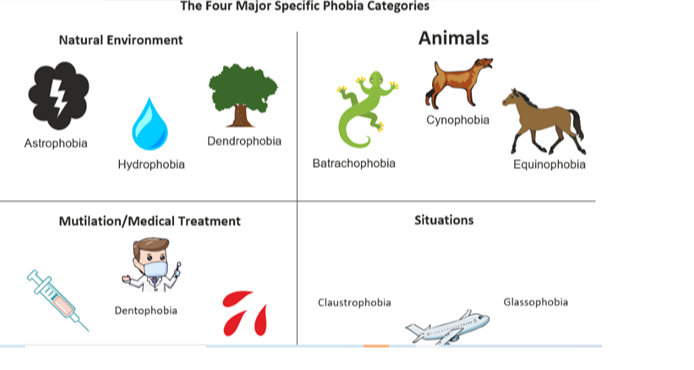Different Types of Specific Phobia Treatments

Different Types of Specific Phobia Treatments
Having and knowing someone with a phobia is more common than you think. According to Healthline a ‘’phobia is an excessive and irrational fear reaction. If you have a phobia, you may experience a deep sense of dread or panic when you encounter the source of your fear. The fear can be of a certain place, situation, or object.’’ Some common phobias include but are not exclusive to a fear of flying, spiders, snakes, heights and swimming.
However, someone can have a specific phobia wherein they experience panic, anxiety and a feeling of dread when they face an object, person, or a specific situation. A specific phobia can be classified as a type of anxiety disorder where a person has an irrational fear or aversion to someone or something. These extreme fears can be detrimental to their personal life, in their work, school, and can interfere with them enjoying a normal life.
Be rest assured that iIf you have or know someone who has a specific phobia, there are specific phobia treatments available today brought by the advances in modern psychology. If you are concerned about a specific phobia and want to seek treatment, here are different types of specific phobia treatment.
- Cognitive Behavioral Therapy
Cognitive behavioral therapy, also popularly known as the ‘talking therapy’ is a psychotherapy that seeks to improve the mental health of an individual. When one undergoes CBT, a CBT therapist helps the individual change negative thought patterns, feelings and behavior to improve the emotional and mental health. By doing so, the individual can regulate their own emotion, change past behaviors, improve self-esteem and come up with strategies to solve future problems as well as cope with any emotional and mental challenges.
- Medication
An individual who experiences specific phobias that induces feelings of anxiety, intense dread and extreme fear, a presiding psychiatrist might prescribe medication to control or alleviate the anxiety felt. Common medication for phobias include short-acting sedative-hypnotics (benzodiazepines) such as alprazolam, commonly known as Xanax another drug is Lorazepam or Ativan may be prescribed on occasional cases where it is needed by the individual to help reduce anticipatory anxiety.
There is also a common drug called beta-blockers that prevents the stimulation of the adrenergic receptors that can cause cardiac arrest. Beta-blockers are used to control heart rhythm, treat angina, and reduce high blood pressure.
However, a word of warning, before consuming any drug, one must make an appointment and consult with an accredited and licensed psychiatrist to ensure safe and appropriate consumption of any drug. A prescription from a psychiatrist is needed to make sure the correct dosage of drugs is consumed as needed by the individual.
- Exposure Therapy
Exposure therapy is a technique used by therapists in behavior therapy to treat anxiety disorders. Exposure therapy involves exposing the target patient to the anxiety source or its context without the intention to cause any danger. The exposure therapy helps individuals to overcome their anxiety or distress.
Exposure therapy is a therapy that helps those who need help to manage their extreme fears. It helps the people to confront their fears and to any objects or people who bring that fear in a structured and controlled environment.
Exposure therapy’s goal is to help the individual in creating an environment where an individual is exposed to their specific phobias gradually. In doing so, a person can have their anxiety reduced, decrease their intense avoidance of that fear and help them live a better quality of life.
Types of Exposure Therapy
- Imaginal Exposure
In this type of exposure, a person in therapy is asked to mentally confront the fear or situation by picturing it in one’s mind. For example, a person with arachnophobia, a fear of spiders, will be asked to imagine spiders.
- In Vivo Exposure
When In vivo exposure is used, a person will be exposed to real-life objects and in a situational environment. For example, a person with a fear of water, or aquaphobia might go to a swimming pool and touch it.
Virtual Reality Exposure:
Virtual Reality Exposure is a combination of both imaginal and in vivo exposure where a person is introduced to situations that look real-life but are actually made up. For example, a person who has a phobia of snakes or Ophidiophobia will be put in a virtual simulation of having a snake in the room.




